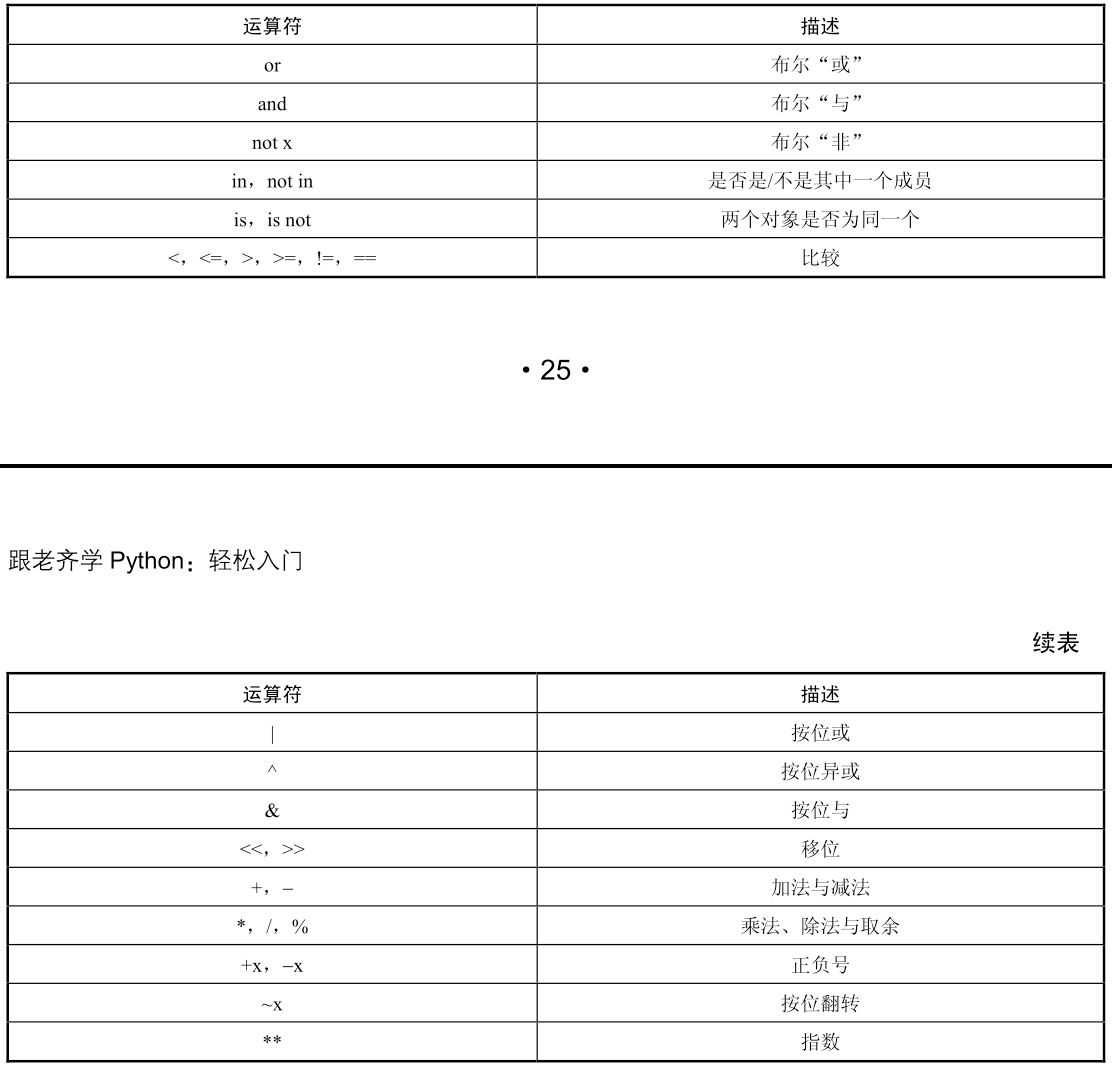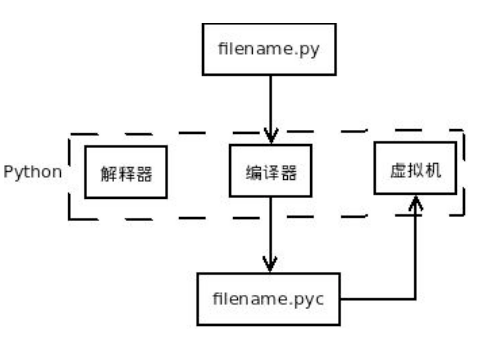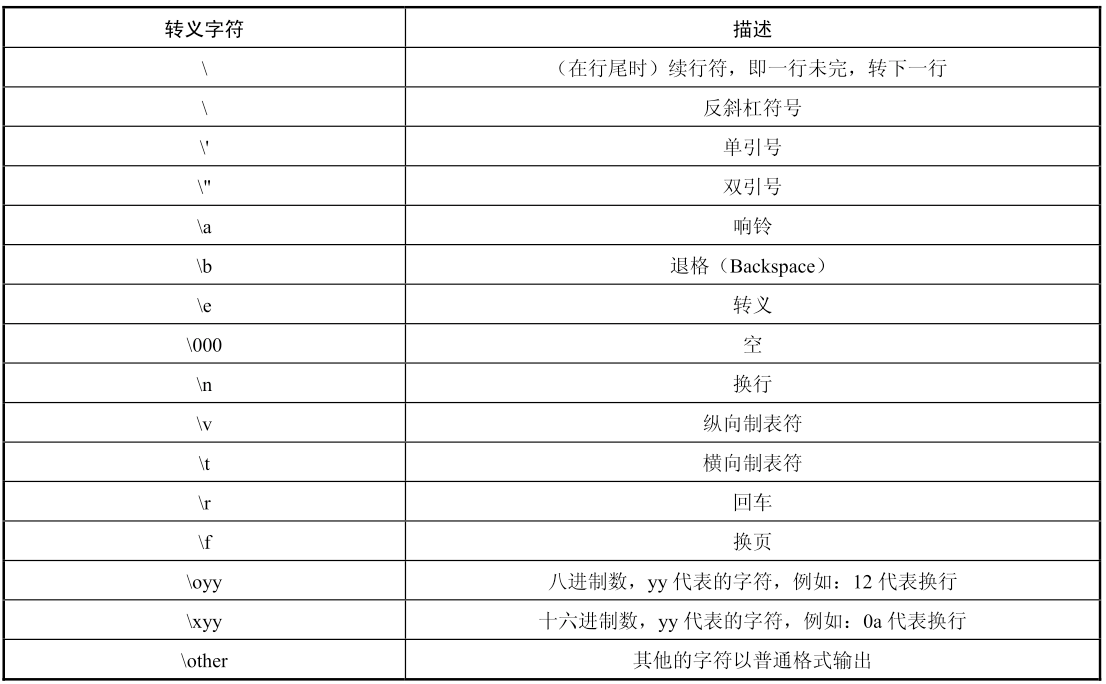老齐python-基础1
1、基本对象类型
1.1数:
>>> 3 #基本数字 3 >>> 3333 3333 >>> 3.222 3.222 >>> id(3) #查看变量的内存地址 139725613539392 >>> id(4) 139725613539424 >>> help(id) #查看帮助 Help on built-in function id in module builtins: id(...) id(object) -> integer Return the identity of an object. This is guaranteed to be unique among simultaneously existing objects. (Hint: it's the object's memory address.) >>> type(3) #查看变量类型 <class 'int'> #返回为int类型 >>> type(3.0) <class 'float'> >>> type(3.22222) #返回为浮点类型 <class 'float'>
1.2变量:
python一个重要特征---对象有类型,变量无类型
>>> x = 5 >>> x 5 >>> x = 6 >>> x 6
1.3四则运算:
在计算机中,四则运算和数学中学习过的四则运算规则是一样的
>>> x = 5 >>> x 5 >>> x = 6 >>> x 6 >>> 2 + 5 7 >>> 5 - 2 3 >>> 10/2 5.0 >>> 10 / 5 + 1 3.0 >>> 2 * 3 - 4
在计算机中,整数不可以无限大,如果计算机结果超出计算机最大数,问题被称为“整数溢出问题”
推荐阅读:http://zhaoweizhuanshuo.blog.163.com/blog/static/148055262201093151439742
1.4大整数:
大整数乘法相关阅读:https://github.com/qiwsir/algorithm/blob/master/big_int.md
>>> 123123123123123213123546546980 * 6712376213576781238976172683168723 826448722992937633540194134897988240054845522368696291386106540
整数,用int表示,来自单词:integer
浮点数,用float表示,即单词:float
1.5浮点数:
遇到非常大或是非常小的浮点数,这时通常会使用一种叫做“科学计数法”的方式来表示。
>>> 9.8 ** -7.2 7.297468937055047e-08
e-08表示10的-8次方,这就是科学记数法。当然也可也使用这种方法写数字
>>> a = 2e3
>>> a
2000.0
超出浮点数范围溢出错误
>>> 500.0 ** 100000 Traceback (most recent call last): File "<stdin>", line 1, in <module> OverflowError: (34, 'Numerical result out of range')
1.6除法:
整数除以整数
>>> 2 / 5 0.4 >>> 2.0 / 5 0.4 >>> 2 / 5.0 0.4 >>> 2.0 / 5.0 0.4
Python3整数除以整数不管什么类型都返回的是浮点数
>>> 5 // 2 2
整除取整,不四舍五入
1.7异常计算:
>>> 10.0 / 3 3.3333333333333335 #python主动结束运算 >>> 0.1 + 0.2 0.30000000000000004 >>> 0.1 + 0.1 - 0.2 0.0 >>> 0.1 + 0.1 + 0.1 - 0.3 5.551115123125783e-17 >>> 0.1 + 0.1 + 0.1 - 0.2 0.10000000000000003
原因是计算机存储位数显示导致0.1转换为二进制后的数不会精确的为10进制0.1就出现了上述现象
python的浮点数而言大多数计算机每次计算误差不超过2的53次方分支1,对于大多数任务来说已经足够了,但是要谨记这不是十进制算法,每个浮点数计算可能会带来一个新的舍入错误。一般情况下,只要简单地将最终显示的结果"四舍五入"到所期望的十进制位数,就会得到满意的最终结果。
对于需要非常精确的情况,可以使用decimal模块
另外,fractions模块支持另外一种形式的运算,他实现的运算基于有理数(因此1/3这样的数字可以精确的表示)。还可以使用NumPy包和其它的数学统计包。
《浮点数算法:争议和限制》:https://docs.python.org/2/tutorial/floatingpoint.html#tut-fp-issues
1.8引用模块解决除法问题:
python中又各种"轮子"供我们使用,那些"轮子"在python中叫"模块"或者“库”,有人承接其他的语言名称,叫做"类库"。
用法:
形式1: import module-name. import后面跟空格,然后是模块名称,如import os
形式2: from modue1 import module11. module1是一个大模块(可以称之为“库”),里面还有子模块module11,只想用module11就这么写
>>> import decimal >>> a = decimal.Decimal("10.0") >>> b = decimal.Decimal("3") >>> a / b Decimal('3.333333333333333333333333333') >>> from fractions import Fraction >>> Fraction(10,3) Fraction(10, 3) >>> Fraction(10,8) Fraction(5, 4) >>> Fraction(10,6) Fraction(5, 3)
1.9余数
>>> 5 % 2 1 >>> 6 % 4 2 >>> 5.0 % 2 1.0
divmod
>>> help(divmod) Help on built-in function divmod in module builtins: divmod(...) divmod(x, y) -> (div, mod) Return the tuple ((x-x%y)/y, x%y). Invariant: div*y + mod == x. >>> divmod(5,2) (2, 1) >>> divmod(9,2) (4, 1) >>> divmod(5.0,2) (2.0, 1.0)
1.10四舍五入
>>> round(1.234567,2) 1.23 >>> round(1.234567,3) 1.235 >>> round(10.0/3,4) 3.3333 >>> round(1.2345,3) 1.234 #没有四舍五入,还是转换2进制的问题 >>> round(2.235,2) 2.23
推荐阅读:https://github.com/qiwsir/algorithm/blob/master/divide.py
1.11常用数学函数和运算优先级
math模块:
>>> import math >>> math.pi 3.141592653589793 >>> dir(math) ['__doc__', '__file__', '__loader__', '__name__', '__package__', '__spec__', 'acos', 'acosh', 'asin', 'asinh', 'atan', 'atan2', 'atanh', 'ceil', 'copysign', 'cos', 'cosh', 'degrees', 'e', 'erf', 'erfc', 'exp', 'expm1', 'fabs', 'factorial', 'floor', 'fmod', 'frexp', 'fsum', 'gamma', 'hypot', 'isfinite', 'isinf', 'isnan', 'ldexp', 'lgamma', 'log', 'log10', 'log1p', 'log2', 'modf', 'pi', 'pow', 'radians', 'sin', 'sinh', 'sqrt', 'tan', 'tanh', 'trunc']
dir() 内建函数
help(dir) Help on built-in function dir in module builtins: dir(...) dir([object]) -> list of strings If called without an argument, return the names in the current scope. Else, return an alphabetized list of names comprising (some of) the attributes of the given object, and of attributes reachable from it. If the object supplies a method named __dir__, it will be used; otherwise the default dir() logic is used and returns: for a module object: the module's attributes. for a class object: its attributes, and recursively the attributes of its bases. for any other object: its attributes, its class's attributes, and recursively the attributes of its class's base classes.
使用help()
>>> help(math.pow) Help on built-in function pow in module math:
#交互模式下输入上面的指令,然后回车键,就会看到下面的信息
pow(...) pow(x, y) Return x**y (x to the power of y).
#这里展示了math种的pow()函数的使用方法和相关说明
#pow(x,y):表示这个函数的参数有两个,也是函数的调用方式。
#Return x**y(x to the power of y):是对函数的说明,返回x**y的结果,并且在后面解释了x**y的含义(x的y次方
>>> 4 ** 2
16
>>> math.pow(4,2)
16.0
>>> 4 * 2
8
>>> math.sqrt(9) 3.0 >>> math.floor(3.14) #四舍五入 3 >>> math.floor(3.92) 3
>>> math.fabs(-2) #绝对值 2.0 >>> abs(-2) 2
>>> math.fmod(5,3) #取余
2.0
>>> 5 % 3
2
1.12运算优先级

1.13程序
#!/usr/bin/env python3 # coding=utf-8 print("Hello, World")
#!/usr/bin/env python3 #pyhton解释器 #coding:utf-8 #编码指定,python3中默认是utf8,python2中需要指定 """ 请计算:19+2*4-8/2 """ a = 19 + 2 * 4 - 8 / 2 print(a)
程序编译执行过程

1.14字符串
>>> "I love Python." 'I love Python.' >>> "I LOVE PYTHON." 'I LOVE PYTHON.' >>> type(250) <class 'int'> >>> type("250") #注意加引号后的类型 <class 'str'> >>> print("good good study, day day up") good good study, day day up
print特殊字符处理
>>> 'What's your name?' File "<stdin>", line 1 'What's your name?' ^ SyntaxError: invalid syntax >>> "What's your name?" #方法1双引号 "What's your name?" >>> 'What\'s your name?' #方法2转译符 "What's your name?
变量和字符
>>> b = "hello,world" >>> b 'hello,world' >>> print(b) hello,world
>>> type(b)
<class 'str'
连接字符串
>>> "py" + "thon" 'python' >>> "py" - "thon" #str类型不支持减 Traceback (most recent call last): File "<stdin>", line 1, in <module> TypeError: unsupported operand type(s) for -: 'str' and 'str' >>> a = 1989 >>> b = "free" >>> a + b Traceback (most recent call last): File "<stdin>", line 1, in <module> TypeError: unsupported operand type(s) for +: 'int' and 'str' >>> b + str(a) #转换之后相加 'free1989'
>>> b + repr(a) #另一种方法
'free1989
>>> a = "250" >>> b = int(a) >>> b 250 >>> type(b) <class 'int'>
1.15python转义符

>>> print("hello. I am qiwsir.\ ... My website is 'http://qiwsir.github.io'.") hello. I am qiwsir.My website is 'http://qiwsir.github.io'. >>> print("you can connect me by qq\\weibo\\gmail") you can connect me by qq\weibo\gmail
1.16 键盘输入
内建函数:https://docs.python.org/3.5/library/functions.html
help(input) Help on built-in function input in module builtins: input(prompt=None, /) Read a string from standard input. The trailing newline is stripped. The prompt string, if given, is printed to standard output without a trailing newline before reading input. If the user hits EOF (*nix: Ctrl-D, Windows: Ctrl-Z+Return), raise EOFError. On *nix systems, readline is used if available. (END)
>>> input("input your name:")
input your name:python #提示输入内容,通过键盘输入python
'python'
>>>
>>> name = input("input your name:") input your name:python #将输入信息传入变量 >>> name 'python' >>> type(name) <class 'str'>
>>> age = input("How old are you?") How old are you?10 >>> age '10' >>> type(age) <class 'str'>
#!/usr/bin/env python3 # coding=utf-8 name = input("What is your name?") age = input("How old are you?") print("Your name is:", name) print("You are" + age + "years old.") after_ten = int(age) + 10 print("You will be " + str(after_ten) + "years old after ten years.")
字符输入小程序
1.17原始字符串
>>> print("I like \npython") I like #\n换行 python >>> dos = "c:\news" >>> dos 'c:\news' #打印后出现的问题 >>> print(dos) c: ews #解决方法1 >>> dos = "c:\\news" >>> print(dos) c:\news >>> dos = r"c:\news" #解决方法2 >>> print(dos) c:\news >>> print(r"c:\news\python") c:\news\python
python保留字:某些变量名,文件名,函数,类等命名是不能被使用的
>>> import keyword >>> keyword.kwlist ['False', 'None', 'True', 'and', 'as', 'assert', 'break', 'class', 'continue', 'def', 'del', 'elif', 'else', 'except', 'finally', 'for', 'from', 'global', 'if', 'import', 'in', 'is', 'lambda', 'nonlocal', 'not', 'or', 'pass', 'raise', 'return', 'try', 'while', 'with', 'yield'] >>>


